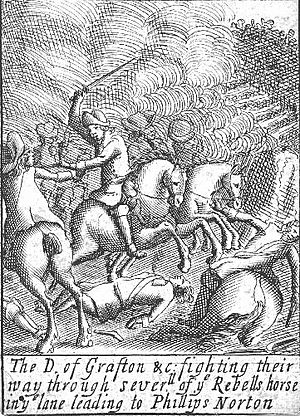Battle of Norton St Philip facts for kids
Quick facts for kids Battle of Norton St Philip |
|||||||
|---|---|---|---|---|---|---|---|
| Part of The Monmouth Rebellion | |||||||
 |
|||||||
|
|||||||
| Belligerents | |||||||
| Commanders and leaders | |||||||
| Strength | |||||||
| 5,000 | 7,000+ | ||||||
| Casualties and losses | |||||||
| 20 killed 50+ wounded some captured |
24 killed 40 wounded |
||||||
The Battle of Norton St Philip was a fight that happened on June 27, 1685. It took place in a village called Norton St Philip in Somerset, England. This battle was part of the Monmouth Rebellion, a time when people rebelled against the King. It was the last time the rebel army won a battle.
Contents
What Led to the Battle?
After another battle near Keynsham, Monmouth and his rebel army wanted to reach London. They tried to move faster than the King's army. On June 26, they arrived at Norton St Philip. The rebels were very tired, so they set up camp near the village. They put guards out and built roadblocks to protect themselves.
The King's commander, Earl of Feversham, found out where Monmouth was. He gathered all his soldiers in Bath. On the morning of June 27, Feversham marched his army towards Monmouth's position.
Who Fought in the Battle?
Here are the main groups and leaders who fought:
The King's Army
The King's army was led by the Earl of Feversham.
- They had different types of soldiers, including Foot Guards and Grenadiers.
- John Churchill led a group called Churchill's Brigade.
- They also had cavalry (soldiers on horseback) and musketeers.
- Local soldiers from Somerset and Dorset also joined the King's side.
The Rebel Army
The rebel forces were led by the Duke of Monmouth.
- His army was made up of different regiments, like the Duke's (Red) Regiment and the Blue (Taunton) Regiment.
- Nathaniel Wade was a key leader in the rebel army.
- They also had their own cavalry and artillery (cannons).
How the Battle Unfolded
On the morning of June 27, most of Monmouth's army started marching towards Frome. Only a small part of the rebels stayed behind at Norton. Monmouth himself led this group, acting as a rear-guard to protect the main army.
Around 11 AM, the first soldiers from Feversham's army arrived. They attacked the rebel roadblocks. After a short fight, the King's soldiers pulled back to report to Feversham.
Feversham then ordered Grafton to attack the barricade again with more soldiers. A fierce fight started. The rebels, led by Nathaniel Wade, brought up more of their men. The King's soldiers were almost surrounded, but more of their troops arrived to help. They fought their way back up the lane. Some even cut through thick hedges to escape.
To help his men escape, the King's musketeers fired at the rebels. This forced another rebel group, the Green Regiment, to move forward and fight back. They were helped by rebel cavalry. The rebels pushed the King's soldiers back. Monmouth's men cheered as they captured the hedges. Monmouth brought up his cannons and started firing.
By 3 PM, it was raining heavily. Feversham also brought up his cannons to fire back. He had more foot soldiers and cannons than Monmouth. However, Feversham's army was on a hill, a strong defensive spot. This meant the rebels would have to attack uphill.
For two hours, both sides fired cannons at each other. But not much damage was done. Around 5 PM, Feversham decided to pull his army back. The King's army left the battlefield, heading towards Bradford-on-Avon. This meant Monmouth's cheering forces had won the battle. It was the last victory for the rebels in the rebellion.
What Happened After the Battle?
Feversham reported that the King's army had few losses. About 20 men were killed, and over 50 were wounded. Some were also captured. The rebels lost 4 officers and 20 men killed, and over 40 wounded. No rebels were taken prisoner.
Even though the rebels won at Norton St Philip, they lost a whole day of marching towards London. Their army was also more tired. Monmouth marched to Frome on June 28. He still planned to go to London. But then he heard that Feversham's army had moved to Westbury. This move could block Monmouth's path to London.
Monmouth realized that to reach London, he would have to fight a big, open battle against the King's army. He knew his rebel forces, who were not well-trained, were not ready for such a fight. So, he decided to turn back into Somerset. This meant he gave up the small advantage he had gained.
After this battle, over 2,000 men left Monmouth's army. This was a big problem for the rebels. Monmouth hoped to join forces with other groups of rebels. His army reached Shepton Mallet on June 30 and Wells on July 1. Monmouth's journey through Somerset in early July led his army to Sedgemoor. There, they fought the final and most important battle of the rebellion on July 6, known as the Battle of Sedgemoor.

